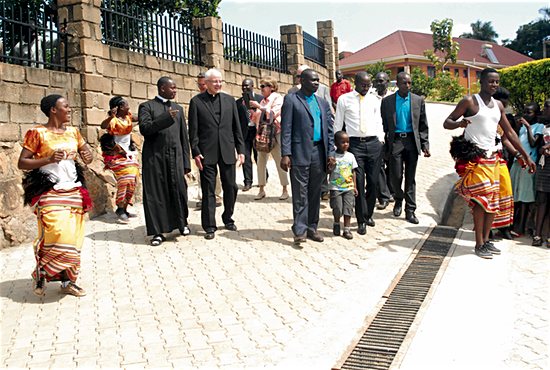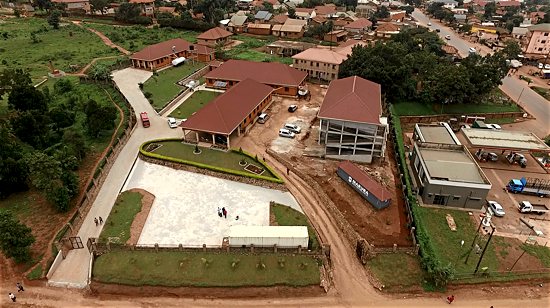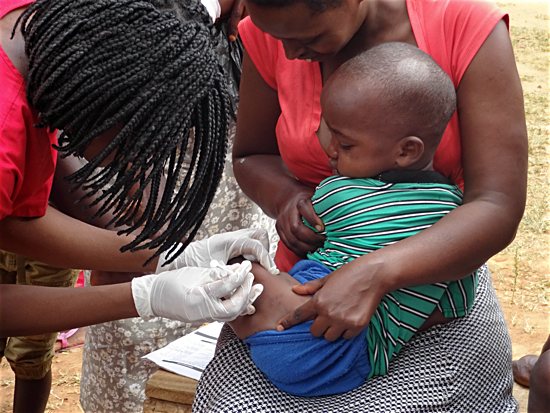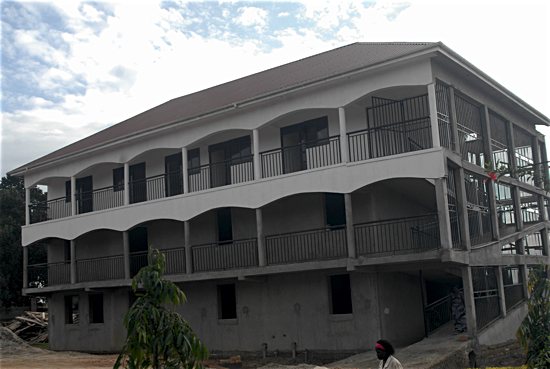
Shamim Najjuuko sat on a bed in a hospital room in May, finally healthy and anxious to return home to her 2-month-old baby.
She was gravely ill a week earlier when a friend brought her to Ruth Gaylord Hospital in Maganjo on the outskirts of Kampala, Uganda’s capital city. She had received initial care at a clinic, where she had been diagnosed with typhoid fever, but prescription drugs had not improved her condition.
“She was not walking because she was in so much pain,” said Salam Nakiwala, her grandmother.
Hospital physicians ran tests, decided surgery was necessary and discovered an intestinal perforation and a sepsis-like condition. A surgeon repaired the perforation and a week later Najjuuko was ready for discharge. “I’m feeling good now,” the 19-year-old said.
“I am happy, and I feel loved. I want to go home.”
“She was very sick because she was so septic,” said Dr. Lawrence Sserubiri, who treated Najjuuko. “If we had not operated, she would have died.”
Najjuuko’s situation was similar to many others treated over the last three years in this hospital, a testament to the vision of a St. Paul priest who was troubled a decade ago by the scarcity of quality health care in Uganda and did something about it.
Today, Father Dennis Dease looks back with pride on what Ruth Gaylord Hospital has accomplished, and he looks ahead with confidence that thousands of Ugandans will receive the best care at affordable prices.
“This has been immensely gratifying,” said Father Dease, who was president of the University of St. Thomas in St. Paul from 1991 to 2013. “It’s especially gratifying to see Tommies doing this work. It is the entrepreneurial spirit of [Archbishop] John Ireland still at work today. He was an enthusiastic leader who started parishes, colleges, hospitals and orphanages. He was a great builder, and to see one of his institutions continue that spirit on the other side of the world is amazing.”

Recognizing a need
So just how — and why — did Father Dease and St. Thomas alumni get involved in building a hospital in an East African country eight time zones away?
The roots were planted in the early 2000s as Father Dease prepared to leave for Uganda to attend an international conference of Catholic university presidents. A donor called to say she would pay a Ugandan’s tuition at St. Thomas if Father Dease could find a student. He did, and many others followed, with more than 50 Ugandans matriculating at St. Thomas to earn bachelor’s and master’s degrees over the course of 15 years.
During occasional trips to Uganda, Father Dease became troubled by health care there. He worked with Charles Lugemwa, a native Ugandan and 2003 St. Thomas alumnus, to open two Hope Medical Clinics in Kampala, but they weren’t enough. After viewing the conditions for pregnant women at a large public hospital, Father Dease was determined to build a hospital.
“For me, it was something like out of a horror movie,” he said. “Mothers were giving birth on the floors in rooms and in corridors. It was really a very disturbing picture. Charles captured what the mission of this hospital is when he said our motto should be, ‘Every mother goes home with a healthy baby, and every baby goes home with a healthy mother.’”
Lugemwa found land owned by a Catholic parish and secured government approvals. Father Dease raised money — more than $500,000 to date — and received gifts in kind, including medical equipment from Matter, a Minnetonka-based nonprofit then known as Hope for the City, and floor and wall tile from RBC Tile & Stone in Plymouth.
Ground was broken in 2010. Three buildings have opened since 2013 and construction soon will conclude on a three-story fourth building, with the top story housing apartments for University of Minnesota surgical residents scheduled to arrive in February 2017. The staff has grown to 40 under the leadership of Lugemwa, hospital board chair and construction supervisor, and Peter Kiggundu, a St. Thomas alumnus who returned home two years ago as chief executive officer. Dr. Godino Kalungi, another St. Thomas alumnus, will become medical chief of staff next year.
Father Dease visited the hospital, named for longtime Twin Cities music educator Ruth Gaylord, in May. Hundreds of Ugandans turned out for a ceremony to dedicate a building and receive free checkups from doctors, midwives, nurses and dentists. Each month, they care for 1,200 people who suffer from malaria, typhoid fever, infections and other diseases.
Sserubiri specializes in obstetrics and gynecology. Medicine is a family tradition — two brothers and an uncle also are doctors — and he finds joy in treating patients like Najjuuko “and seeing them get better,” he said. “It is amazing.”
Juliet Nalwoga has worked as a midwife at the hosptial since last December. She appreciates the caring atmosphere, and she doesn’t hesitate to stay overnight to keep an eye on a patient. “I really like taking care of children,” she said.
And receptionist Molly Nattabi is a gatekeeper who manages traffic flow. “It has been busy,” she said, pointing to the crowded waiting room. She already had checked in 16 outpatients by 11 a.m., on top of 48 patients the previous day. “So busy!”
At the helm are Lugemwa and Kiggundu. Father Dease calls them “servant leaders” of the highest order. Lugemwa is “a miracle worker,” he said, in balancing his hospital efforts with a full-time job as a Uganda Revenue Authority manager and responsibilities as the father of five children, while Kiggundu “has done a splendid job of running the hospital.”
Lugemwa deflects the praise. “I don’t believe we could do all of this without God’s help,” he said. “The direction we took has been guided by the Lord.”
He initially was attracted to the project because his baby daughter died several years ago after she received the wrong medication. Later, he became frustrated during his work at the clinics when patients he referred to hospitals couldn’t afford to pay the fees.
“It felt like we were condemning them,” he said. “I discussed this with Father Dease and we said, ‘OK, maybe we need to look at starting our own hospital.’”
An early donation from Msgr. James Habiger, the retired Minnesota Catholic Conference director, was critical. Msgr. Habiger, who died four years ago, had become aware of plans for the clinics and told Father Dease that he wanted to help. As the lead donor, Msgr. Habiger asked Father Dease if the hospital could be named for Gaylord, a lifelong friend who considered herself a “plain, ordinary woman.” When she questioned why her name should be on the hospital, Msgr. Habiger had the answer: “He told me, ‘Because
I want women in Africa to know that a plain, ordinary woman in America cares for them,’” Gaylord recalled.

Words in action
Dozens of other donors followed Msgr. Habiger’s lead. Tom Bisanz, a St. Paul native who lives in Dallas, is one. Father Dease taught Bisanz 45 years ago at St. Thomas Academy in Mendota Heights, and the two have stayed in touch. When the priest told Bisanz about the hospital, he knew what he had to do. A donation led to the naming of a building, the Helen Bisanz Outpatient Centre of Excellence, after his late mother.
“It’s not my money,” he said. “I’m just a conduit. It is God’s money, and he tells me where to give. It’s fruitful giving — it’s not a leap of faith. I like that it is a hospital in a Third World country and is run by St. Thomas alumni. And I like its mission: saving lives, healing people.”
The hospital opened in March 2013. Lugemwa and Father Dease knew they needed to hire a CEO to manage day-to-day operations. They turned to Kiggundu, who has bachelor’s and master’s degrees in business from St. Thomas.
“Peter understood and valued the vision, and we knew he would make sacrifices,” Lugemwa said. “There was concern he was young (then 29) and had just graduated. But he believed in himself as much as we believed in him. If he didn’t have that belief and that confidence, it could not have worked.”
As Lugemwa speaks, Kiggundu listens quietly. He jokes about his first months as “baptism by fire” with “challenges that you can’t imagine,” but he persevered. He has doubled the size of the staff, expanded labs, purchased an ambulance and opened an operating room, with the first surgery conducted a year ago. Outreach efforts include free immunization clinics in schools and villages, with free vaccinations provided by the government.
“Charles has been a great mentor,” Kiggundu said. “He has helped me understand the big picture of where we want to go as a hospital.”

Kiggundu covers expenses while tucking away small monthly surpluses that will be used to replace smaller equipment. Father Dease hopes to create an endowment to replace larger equipment, and there have been discussions about installing a water reservoir, pasteurizing water using solar energy and constructing affordable housing on adjacent land, with income supporting the hospital.
One May evening, while sitting in his home, Lugemwa mentioned he had read about St. Thomas’ new brand, “All for the Common Good.”
“Our hospital,” he said, “is a demonstration of how St. Thomas has moved from a billboard into a community.”
As he spoke, Lugemwa cradled an infant who has become, in a sense, a poster child for the hospital.
A premature newborn weighing less than 3 pounds, she was abandoned outside the hospital gates Dec. 9, 2015. A passerby heard a noise, discovered her and took her into the hospital. Before long, she was big enough to go home to her adoptive family — Lugemwa, his wife, Maria, and their children Conrad, Conley, Colleen and Cornelius. By Valentine’s Day, she weighed more than 7 pounds.
Her name? Ruth.
“In baby Ruth,” Lugemwa said, “we see the real fruits of our labor.”
Hennes is vice president for government relations and special projects at the University of St. Thomas. Contributions to Ruth Gaylord Hospital are fully tax deductible and can be sent to: Friends of East Africa Foundation, 2130 Summit Ave., St. Paul, MN 55105.
Photos Courtesy Doug Hennes



